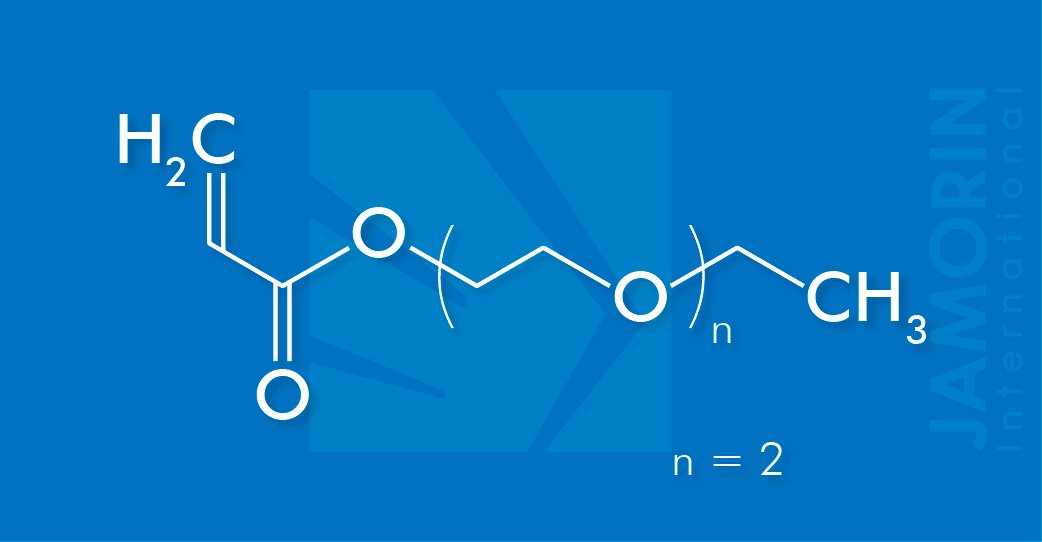C9H16O4
min. 90.0 %
C9H16O4
min. 90.0 %
Ethyldiglycol Acrylate (EDGA)
Ethyldiglycol Acrylate (EDGA) is an ester of Acrylic acid and is used as a raw material component in the synthesis of polymers. Ethyldiglycol Acrylate (EDGA) is a monofunctional monomer consisting of an acrylate group with a characteristic high reactivity and a cyclic hydrophobic group. Ethyldiglycol Acrylate (EDGA) forms homopolymers and copolymers. Copolymers of Ethyldiglycol Acrylate (EDGA) can be prepared with (meth)acrylic acid and its salts, amides, and esters, and with (meth)acrylates, acrylonitrile, maleic acid esters, vinyl acetate, vinyl chloride, vinylidene chloride, styrene, butadiene, unsaturated polyesters, and drying oils, etc.
Ethyldiglycol Acrylate (EDGA) is a very useful starting material for chemical synthesis since it easily undergoes addition reactions with a wide range of organic and inorganic compounds.
Product Type: Acrylate Monomer
Features & Benefits:
- Adhesion
- Low VOC
It is applied in the production of:
- Automotive Coatings
- Industrial Coatings
- Plastics
- Adhesives
- UV Curables
Chemical Properties:
-
Puritymin 90.0 %
-
Acid Valuemax 0.1 %
-
Water contentmax 0.1 %
-
Color APHAmax. 150
Physical Properties:
-
AppearanceClear, colorless
-
Physical formliquid
-
Odorester-like
-
Molecular weight188.3 g/mol
-
Density1.0028 g/cm3 at 25 °C
-
Boiling Point95 °C at 5 hPa
-
Freezing Point– 61.9 °C
-
Viscosityapprox. 5 mPa · s at 25 °C
-
Vapor Point0.153 mbar at 38.9 °C
In order to prevent polymerization, Ethyldiglycol Acrylate (EDGA) must always be stored under air, and never under inert gases. The presence of oxygen is required for the stabilizer to function effectively. It has to contain a stabilizer and the storage temperature must not exceed 35 °C. Under these conditions, a storage stability of one year can be expected upon delivery. In order to minimize the likelihood of overstorage, the storage procedure should strictly follow the “first-in-first-out” principle. For extended storage periods over 4 weeks it is advisable to replenish the dissolved oxygen content. Storage tanks and pipes should be made of stainless steel or aluminum. Storage tanks, pumps and pipes should be earthed.
Storage & Handling:
In order to prevent polymerization, Ethyldiglycol Acrylate (EDGA) must always be stored under air, and never under inert gases. The presence of oxygen is required for the stabilizer to function effectively. It has to contain a stabilizer and the storage temperature must not exceed 35 °C. Under these conditions, a storage stability of one year can be expected upon delivery. In order to minimize the likelihood of overstorage, the storage procedure should strictly follow the “first-in-first-out” principle. For extended storage periods over 4 weeks it is advisable to replenish the dissolved oxygen content. Storage tanks and pipes should be made of stainless steel or aluminum. Storage tanks, pumps and pipes should be earthed.
A Safety Data Sheet has been compiled for Ethyldiglycol Acrylate (EDGA) that contains up-to-date information on questions relevant to safety.
The data contained in this publication are based on our current knowledge and experience. In view of the many factors that may affect the processing and application of our product, these data do not relieve processors from carrying out their own investigations and tests; neither do these data imply any guarantee of certain properties, nor the suitability of the product for a specific purpose. Any descriptions, drawings, photographs, data, proportions, weights, etc. given herein may change without prior information and do not constitute the agreed contractual quality of the product. It is the responsibility of the recipient of our products to ensure that any proprietary rights and existing laws and legislation are observed.
